
English: map of Gettysburg battle 3/3 Category:Battle maps of the American Civil War (Photo credit: Wikipedia)
Gettysburg was one of the most meaningful and emotional stops on our history road trip last summer. If you are planning a visit in honor of the 150th Anniversary of the Battle of Gettysburg this year, we’ve got some background and tips for you.
The Gettysburg Campaign was Confederate General Robert E. Lee‘s second invasion of the north during the American Civil War. The objective was to remain in strategic control of the little village where five main roads converged, in order to further advance toward Harrisburg and perhaps even Philadelphia. Had General Lee succeeded, the Civil War’s trajectory would have been far different.
Instead, in three days of heavy fighting, Union forces initially fell back, defended positions in and around the town, and thwarted General Pickett’s famous charge causing the ultimate retreat of Lee’s forces back into Virginia. The aftermath – over 50,000 casualties from both sides – overwhelmed the town of Gettysburg and the nation, resulting in a visit from President Lincoln to dedicate the National Cemetery established on the site the following autumn, and, of course, to deliver his famous Gettysburg Address.
When we visited on a series of bright summer days, it was still impossible not to feel the vestiges of the pall of horror and grief that descended upon the town as the thousands of wounded were attended to and the dead buried. It soon became obvious that there was an enormous amount to see and learn.

Detail of the 1883 cyclorama painting “The Battle of Gettysburg”, “The High Water Mark at Gettysburg” (Photo credit: Wikipedia)
The Gettysburg Foundation works with the National Park Service to “enhance preservation and understanding of the heritage and lasting significance of Gettysburg” and operates the Gettysburg Museum and Visitor Center. We spent an entire day there, and could’ve easily spent another. The Museum’s vintage cyclorama painting is an intense audio and visual experience. French artist Paul Philippoteaux spent months on the battlefield itself and then a year to paint the 42 x 377 ft painting which puts the visitor in the center of Pickett’s Charge. Don’t miss!
There are several ways to tour the battlefield: self-directed auto tour with CD and bus are popular options. Upon a friend’s recommendation, we chose to hire a licensed battlefield guide. At a cost of $65, our tour guide, Ed Guy, drove us, in our own vehicle, around the battlefield for two hours. Ed’s tour was comprehensive, humorous, and peppered with wonderful anecdotes that proved how passionate he was about his subject matter. Having a personalized narrative of events as they unfolded in the places they occurred was an outstanding way to see and feel the battlefield experience.
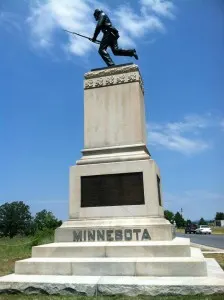
“…to the last man standing” in defiance of Pickett’s Charge.
1st Minnesota Regiment Memorial
We were particularly touched that our guide had chosen to research items that would be of special interest to us as Minnesotans. We learned how Minnesota’s 1st Volunteer Infantry was conscripted back home, and how its valor at Cemetery Ridge (82% casualty rate) assisted in holding a key position. These brave Minnesotans who had already suffered tremendous losses in the Battles of Bull Run and Antietam were ordered to charge into a situation where they were outnumbered 5:1. President Calvin Coolidge later described the 1st Minnesota as the “saviors of our country.” Needless to say, we were very moved.
Experiencing Gettysburg isn’t just about the battlefield and museum. There is plenty to see and do in town, as well. When you walk the streets, you gain different perspectives: stories of civilians prior to and during the battle and its aftermath, homes and businesses that were in the line of fire or commandeered for military purposes, and a heightened sense of how great the cost in human life to defend what really is a very small geographic area. I couldn’t help but think that Gettysburg (pronounced “gettisburg” by locals, as opposed to “gettiesburg” as we had been doing) was about the same size as my hometown. When one considers 19th century standards in medicine and sanitation, as well as shortages of trained medical professionals and supplies, it is easier to understand the effect of the war’s bloodiest battle and its aftermath on the citizens of Gettysburg.
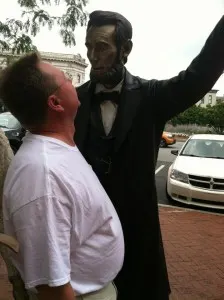 Gettysburg’s main intersection, now known as Lincoln Square, is where the strategic highways so important to both armies still meet. While there are several places of historical significance around the square, you won’t want to miss the David Wills House. Wills was a prominent attorney in Gettysburg, and it was here in a second floor bedroom that President Lincoln stayed and finalized his famous speech the night before the cemetery dedication. The room has been restored to its 1863 appearance, along with Wills’ office. It is not difficult to experience a “moment” in Lincoln’s room. There is a psychic heaviness that lingers here. Fortunately, Pete lifted the mood with a playful pose outside where a life-size statue of Lincoln stands on the brick sidewalk. During your visit to the Wills home, you will also enjoy a detailed diorama of the town as it appeared in 1863, and several galleries of memorabilia. Highly recommended.
Gettysburg’s main intersection, now known as Lincoln Square, is where the strategic highways so important to both armies still meet. While there are several places of historical significance around the square, you won’t want to miss the David Wills House. Wills was a prominent attorney in Gettysburg, and it was here in a second floor bedroom that President Lincoln stayed and finalized his famous speech the night before the cemetery dedication. The room has been restored to its 1863 appearance, along with Wills’ office. It is not difficult to experience a “moment” in Lincoln’s room. There is a psychic heaviness that lingers here. Fortunately, Pete lifted the mood with a playful pose outside where a life-size statue of Lincoln stands on the brick sidewalk. During your visit to the Wills home, you will also enjoy a detailed diorama of the town as it appeared in 1863, and several galleries of memorabilia. Highly recommended.
There are several places to stop and enjoy a bite or libation on or around Lincoln Square. We liked McClellan’s Tavern in the historic Gettysburg Hotel. We also enjoyed the more casual Blue and Gray Bar and Grill and the fanciful Pub and Restaurant. If you take a left from the David Wills House and walk down Baltimore Street from Lincoln Square, you’ll be on one of the main routes that Union soldiers advanced toward Confederate lines, and then used to fall back toward Cemetery Hill on the first day of battle. The Farnsworth House Inn Restaurant at 401 Baltimore features period dining in both tavern and garden settings. This was a site for Confederate sharpshooters, with more than 100 bullet holes from the battle still visible in this building. The Farnsworth House Tavern was used as the set for the Officers Club in the movie Gettysburg, and the movie plays in a continuous loop on the bar’s TV. The Farnsworth House also holds a ghost tour in the building’s cellar which is purportedly haunted. We listened to a litany of mildly entertaining stories during their presentation and were not convinced, although the setting was creepy.
- Farnsworth House Tavern
- Gettysburg movie memorabilia
Proceeding down Baltimore Street, you may be interested in the Rupp House (451 Baltimore), which was used after the family escaped as Brig. Gen. Albert G. Jenkins’ post. Now a museum with interactive displays on 19th century life and culture, and home to the Friends of Gettysburg, the Rupp House is a little gem that will give you an authentic look at the way things were for the average citizen at the time. The family’s story during the battle is compelling; a letter John Rupp wrote after the war described Union soldiers on the front porch and Confederates on the back porch, firing shots at each other through the house while the family hid in the cellar. Note that the original house was so damaged, Rupp rebuilt the structure in 1868 that still stands today.
Further down Baltimore Street, just before it veers off and becomes the Baltimore Pike is the Jennie Wade House at number 548. Twenty year old Jennie Wade was the only civilian casualty during the battle. In the family kitchen, so the story goes, Jennie was kneading bread dough when bullets came through the door. You’ll be able to see the door still peppered with bullet holes, along with other artifacts. Several sources claim experiences with Jennie’s ghost at this location.
We bookended our visit to Gettysburg with experiences at two establishments that we can highly recommend. The first is Hickory Bridge Farm, outside of town about 9 miles in a little fork in the road called Orrtanna. This is a private, family-style, all-you-can-eat experience in an historic barn on a picture perfect farm located off the Lincoln Highway. We enjoyed the traditional, country dishes such as pit roasted beef, fried chicken and crab imperial with corn fritters and vegetables, as well as the peaceful atmosphere. Be warned there are limited hours and alcohol is not served. You will want to call ahead for reservations.
The second is Dobbin House Tavern, in the oldest building in Gettysburg, dating back to 1776. There is a more formal dining room, but you’ll want to descend into the tavern space, called the Springhouse Tavern, for the most authentic experience. The bar has the original bars that were lowered to secure the liquor in the old days, and we enjoyed tasty onion soup and other authentic tavern fare in a dimly lit atmosphere that took us back. Don’t miss the tiny staircase passing by the secret place where slaves traveling the Underground Railroad were hidden.
- Hickory Bridge Farm
Obviously, there is much, much more to see and do in Gettysburg. As we frequently do, we realized we could’ve easily spent several more days in the area. One tip we can pass along is you do not have to stay in Gettysburg itself. Hotel rooms are at a premium in Gettysburg, and a short drive away will provide lots of savings. Distances in this part of Pennsylvania will seem short to folks from the Midwest and other parts of the country, so don’t be afraid to seek lodging in adjacent communities.
Enjoy and revere our history!
Tips for Trip Success
Book Your Flight
Find an inexpensive flight by using Kayak, a favorite of ours because it regularly returns less expensive flight options from a variety of airlines.
Book Your Hotel or Special Accommodation
We are big fans of Booking.com. We like their review system and photos. If we want to see more reviews and additional booking options, we go to Expedia.
You Need Travel Insurance!
Good travel insurance means having total peace of mind. Travel insurance protects you when your medical insurance often will not and better than what you get from your credit card. It will provide comprehensive coverage should you need medical treatment or return to the United States, compensation for trip interruption, baggage loss, and other situations.Find the Perfect Insurance Plan for Your Trip
PassingThru is a participant in the Amazon Services LLC Associates Program. As an Amazon Associate I earn from qualifying purchases.
To view PassingThru’s privacy policy, click here.

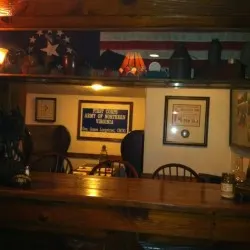
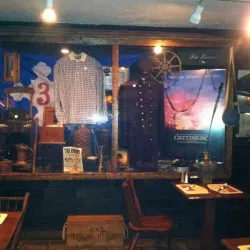
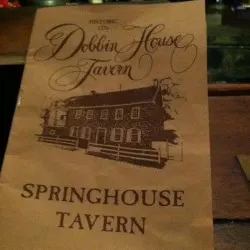
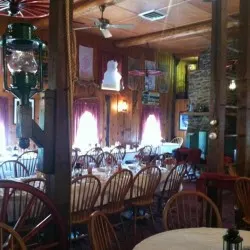
Adrian Amy
Wednesday 21st of January 2015
Really great looking website! Everything seems very easy to look at and use. Did you personally design this or did you have some help?
Also, very interesting article on Gettysberg. I traveled through Harrisburg a few years back and stayed a night there. It had the same "psychic heaviness" around it, but I think it was because of the end of the steel industry.
Betsy Wuebker
Wednesday 21st of January 2015
Hi Adrian - Thank you. You're right about Harrisburg and the Pittsburg area. The loss was economic and very hard hitting. Interesting how we can pick up on the residual energy.
Patriot Politics (@TAKINGNOTICE)
Friday 24th of May 2013
Via PassingThru: Visiting Gettysburg http://t.co/F65pJ2Okis #li #travel #freedom